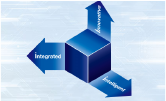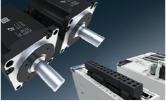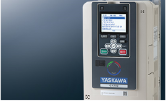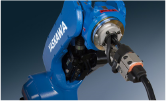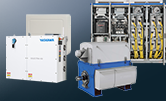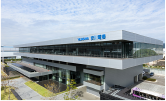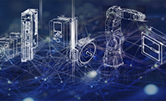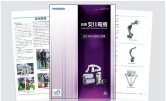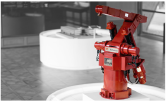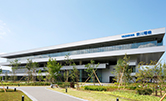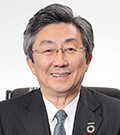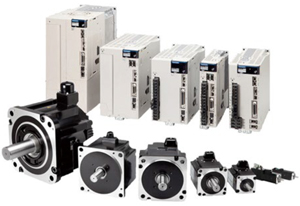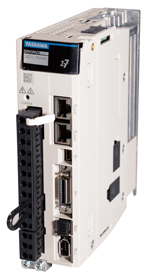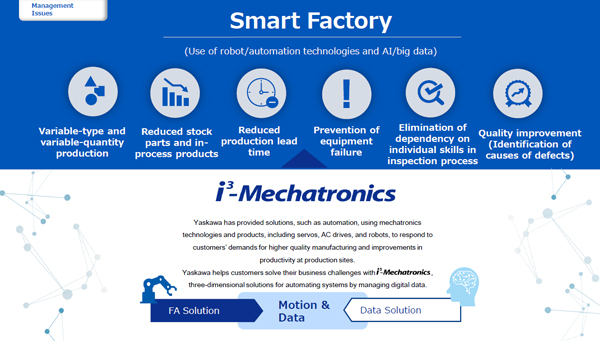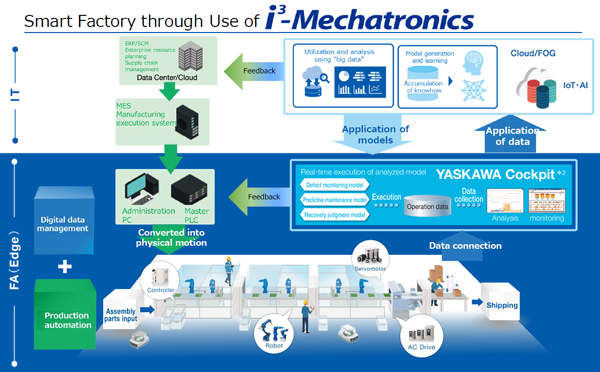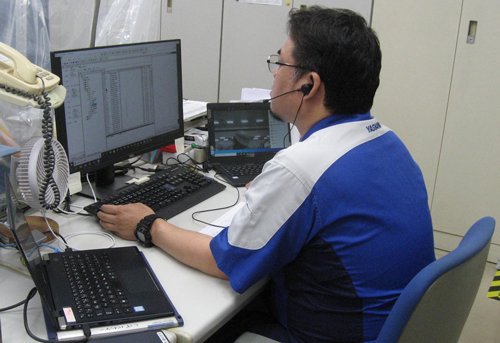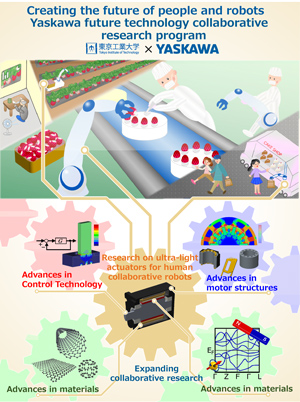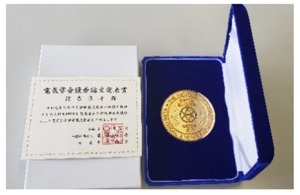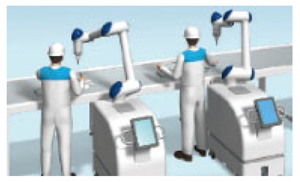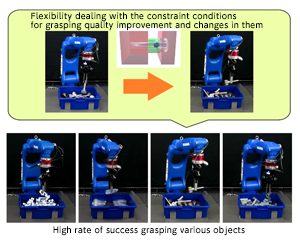Technical Progress in 2020
Preface
Representative Director, President
Hiroshi Ogasawara
The year 2020 was the year when the new coronavirus infections (hereinafter referred to as COVID-19) spread. I would like to express my deepest condolences to those who have passed away and my deepest sympathy to those who have been infected.
The business results of our company were also impacted by the spread of the COVID-19 infections, as companies around the world increasingly held back on capital investment and the situation became very severe. On the other hand, in China, not only did the economic conditions normalize very rapidly, there was also active investment related to new infrastructure, particularly centered on the next-generation communication standard 5G, and this helped support the business achievements of our company. In other regions too, although the end of the COVID-19 crisis is still nowhere in sight, there has been a recovery in automobile sales in the United States and also a rising trend in the semiconductor market in general, and these have supported the emergence of specific capital investment trends.
Under these circumstances, our company has been promoting initiatives for the achievement of our new mid-term business plan “Challenge 25,” which is the second stage of our “Vision 2025” long-term business plan. One of the basic policies defined in our “Challenge 25” is to “Transform business models through i3-Mechatronics (i cube mechatronics).” In the area of technology development, we accelerated the integration of our development system as preparation for the opening of the Yaskawa Technology Center, to aim to strengthen our development capabilities for the promotion of “i3-Mechatronics.” Furthermore, in addition to promoting “i3-Mechatronics,” we also stated our aim to “Build the foundations for digital management through the promotion of the YDX (Yaskawa Digital Transformation) project.” We positioned 2020 as the first year of YDX and began the activities in earnest. The use of the term DX (Digital Transformation) has spread rapidly due to the impact of the COVID-19 crisis. The general definition of DX is that “the spread of IT further enriches people’s lives.” However, YDX replaces this definition with one in our own style, that “digital management reforms business models and establishes competitive advantage.” We have produced concrete results in this, such as the establishment of teleworking and the unification of various types of information.
The technology development in each individual business area in 2020 was as follows.
In our Motion Control Division, we expanded the range of products compatible with the new-generation open field network MECHATROLINK-4 and advanced its application to controller and servo drive products. We also equipped the GA500 general-purpose compact high-performance AC drive with a predictive detection function that contributes to stable production by realizing machinery and facilities that do not stop. In our Robotics Division, based on the concept of “i3-Mechatronics,” we are advancing the development of the YRM controller (tentative name), which can convert motion based on the data, and we will construct a digital twin system for cell units. In the future, we will aim for DX in cells. Elsewhere, innovations in information and communication technology such as the introduction of 5G are expected to lead to a great expansion of the 3C (Computer, Communication and Consumer) and semiconductor sectors from now on. In these areas, we are expanding our lineup of human collaborative robots (MOTOMAN-HC series), SCARA robots, and semiconductor wafer robots (SEMISTAR series). These will drive new automation, and we are working to expand the scope of their application. In our System Engineering Division, we implemented the remote trial operation of iron and steel systems, which can also be conducted during the COVID-19 crisis. We are also advancing research using AI for technique to support the management of wastewater treatment operations. In our Clean Power Division, we commercialized a Japanese specification of the XGI1500 power conditioner for photovoltaic power generation. In research and development too, we are working on the development of an environmental vision system for digital twin solutions. Furthermore, in response to the NEV (New Energy Vehicle) regulations that have been enforced in China, we developed a compact, highly efficient drive system that achieves both high driving performance and an extended driving range.
In 2021, the Yaskawa Technology Center will finally start operations. The Yaskawa Technology Center will realize “i3-Mechatronics” as a base that brings together technology from throughout our company group and from open innovation, to perform the timely development of products that will enable our customers to win. The i3-Mechatronics is based on three “i3” steps: integrated, intelligent, and innovative. In the “integrated” aspect, in the integration of our development processes, we will bring together the technology from our entire group to conduct integrated development that includes everything from foundation technology to mass-production prototyping, including production technology. In the “intelligent” aspect, which is the aggregation and creation of knowledge, we will share accurate information in a timely manner to produce products that can win. This includes market information and also information on the strengths and weaknesses of the technologies of our own company and other companies. For the “innovative” aspect, in the creation of innovative technologies, we will promote open innovation centered on industry-academia collaboration, to create dramatic technological innovation and explore the creation of new business in sectors such as agriculture, foodstuffs and logistics. Please have great expectations for Yaskawa solutions as we continue to take on the challenges in new business areas from now on.
[Motion Control Division]Cumulative shipping of AC servo motors reaches 20 million units
It was 1983 when Yaskawa first launched an AC servo motor on the market. In August 2020, our cumulative shipping reached 20 million units. Many customers both in Japan and overseas are using our Σ-7 series, which is currently our main model. We are continuing the evolution of this series, including by strengthening its data detection functions to advance the use of IoT in production sites.
Σ-7 series AC servo drives
[Motion Control Division] Expansion of products compatible with MECHATROLINK-4
i3-Mechatronics (i cube mechatronics) is a solution concept that aims to improve productivity and realize production lines that do not stop, through digital data solutions such as making the production site visible. As steps to realize that concept, we launched two new products that are compatible with MECHATROLINK-4, the open field network that has four times greater transmission efficiency than our previous MECHATROLINK-III. These products were a MECHATROLINK-4 communication command type Σ-7S AC servo drive and one module for the MP3000 series machine controller. These products enable motion control that maximizes system performance, and it also becomes possible to transmit various sensor and motion data to the higher layer without delay, so they contribute to the realization of smart factories.
MECHATROLINK-4 communication
command type Σ-7S AC servo drive
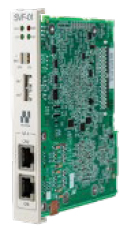

Modules for the MP3000 series
compatible with MECHATROLINK-4
SVF-01
[Motion Control Division] AC drive product enhancement
As the COVID-19 crisis has restricted the movement of people around the world, there has been increased interest in productivity enhancement through the use of Industry 4.0 and other IoT (Internet of Things) technology. This interest has led to demands for the realization of machinery and facilities that never stop by the gathering, visualization, accumulation and analysis of the big data that is generated in various manufacturing workplaces.
We launched the GA700/GA500 AC drive with a predictive detection function in response to those demands. These drives monitor the state of the machinery as they drive the motor. The analysis of the data monitored then makes it possible to prevent trouble on the machinery before it occurs. We also launched an environmentally friendly finless AC drive based on the compact high-performance type GA500. This eliminates the need for maintenance such as fin replacement and fin cleaning, so it achieves facility productivity enhancement.
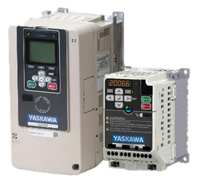
GA700 GA500
AC drive with predictive detection function-
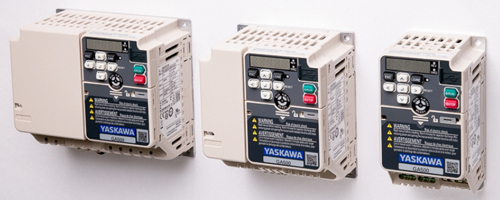
Environmentally friendly finless GA500 AC Drives
[Motion Control Division] Major PR and exhibitions
At the 23rd M-Tech KANSAI exhibition (INTEX Osaka, October 7-9, 2020), we exhibited under the theme of “Providing hints on using data to increase the value of equipment.” We exhibited and demonstrated various products and solutions to solve the issues that customers face in “preventive maintenance,” “productivity enhancement,” and “quality stability.” This was the first time outside the Tokyo area that we had exhibited a concept demonstration machine for our i3-Mechatronics solution concept. In particular, many visitors showed an interest in our “Demonstration of ‘optimizing motion beyond the equipment for motion conversion’,” where the YRM-X controller was used to collect and analyze the data for the entire cell. Some of the other exhibits included a demonstration machine on which the AC drive predicted conveyor failure, a demonstration machine for the sensor network Σ-LINK II, and a demonstration machine for the simultaneous control of motion and robots. Furthermore, in connection with the integration of the group companies performing after sales service from fiscal 2020, we introduced our back office system which connects the YASKAWA Contact Center and the workplaces by using smart glasses.
[Robotics Division] Market conditions and outline of Yaskawa initiatives
There was a fall in demand in FY2019 due to the trade friction between the US and China. There were expectations for a recovery of the market in FY2020, but the havoc of the COVID-19 crisis around the world slowed down economic activity overall and resulted in a decline in demand and no market recovery.
There is currently a temporary dip in the demand, but there has been no great change in the actual requirements for automation, which originate from factors such as insufficient working-age population. At the same time, the robotics industry is still very much in development, such as with requirements for human collaborative robots becoming apparent globally, and the demand connected to that development is expected to continue growing. In the Chinese market, the boost from the recovery of the automotive industry has meant that the recovery of the demand for robots has already progressed remarkably. There has also been some concrete recovery in Europe and the US, with some customers moving to capital investment. We can also expect an increase in demand in Japan too, due to factors such as the advancing recovery of business achievements in the automotive industry. Other promising signs include that the value of semiconductor manufacturing equipment sales has recorded a new record high, which has been due to investment for 5G.
Yaskawa will of course work to capture this recovering and increasing demand from now on, and will also advance the development of key products to achieve preparation for new requirements in the market under the thinking of our i3-Mechatronics solution concept.
The aims of i3-Mechatronics
[Robotics Division] Direction for development
To realize i3-Mechatronics, we are working on activities to improve the quality of user solutions by increasing the usability of data, particularly process data and status data. As part of that, we will realize a digital twin for the facilities in cell units with our YRM-X controller, which is able to control a cell, gather synchronous data on the equipment and robots, and change the motion based on that data. It will then be important that this leads to the DX (Digital Transformation) of the cell so that there can be overall data coordination in the future. Our aim is to steadily advance our “products” towards this kind of trend.
In another area, we are also advancing the practical use of human collaborative robots, which will likely drive the expansion of applications and new automation. The promotion of automation has garnered more and more attention during the COVID-19 crisis. Human collaborative robots are products that motivate users to introduce automation, and they appeal not only to existing robot users, but also to users who are robot beginners and working on new automation.
We are also promoting the utilization of AI in collaboration with the Yaskawa subsidiary AI Cube Inc.
Conceptual image of a smart factory
[Robotics Division] New products launched
We are advancing the development of products that will support the realization of i3-Mechatronics. We have launched a large number of products that respond to the needs of our customers. This includes products such as the MOTOMAN-GP4 high speed handling robot, which has a payload capacity of 4 kg and enhances our lineup of small-sized robots. It also includes the MOTOMAN-PL190 and MOTOMAN-PL320 palletizing robots, which can carry heavier payloads than previous models, have been made easier to use, and are compatible with the YRC1000 controller. We also launched a non-painted MOTOMAN-GP8 for the food industry and the MOTOMAN-MPXL2600 painting robot for general industrial use, and we improved the functions of the HC series of human collaborative robots.
In addition, we expanded our lineup with the development of the SEMISTAR-MU124D series for the handling of semiconductor wafers.
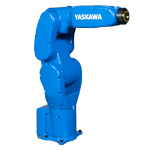
Handling robot
MOTOMAN-GP4
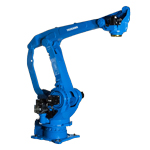
Palletizing robot
MOTOMAN-PL190
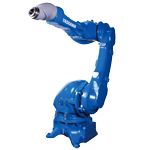
Painting robot
MOTOMAN-MPXL2600
[System Engineering Division] System engineering business overall
The COVID-19 crisis has brought great changes to the way we work and the various industries have searched for and implemented styles for working from home. Regarding the system engineering work, we used web conferencing systems for design meetings, however we had difficulties with the execution of witnessed inspections, where the customer checks the items produced, and with commissioning to operate plants actually, as this involves business trips and visits to the sites. To overcome this, we had customers check the images of the completed products we distributed from inside the plant, like a television broadcast, so that we could implement the witnessed inspections remotely. For the commissioning, we limited the on-site work to the minimum, such as just the operations that require safety checks. We performed the monitoring and operation of the system equipment we had delivered by connecting it via the Internet to a base station in our company plant. We obtained further information on the situation from IoT equipment such as webcams, and implemented the monitoring and operation remotely.
We also used IoT for the periodic audits for certified factories and achieved the auditing and renewals remotely. If we assume that this COVID-19 crisis will continue for some time, then there will likely be even more occasions when remote action will be required. We want to meet our customers’ needs for timely startup by preparing our IT to establish safer and more efficient methods. Also in production activities, we believe that the move to aim for the working style that prevents the crowds and for the contactless working environment, will be accelerated.
Additionally, we will contribute to improving working style under the COVID-19 crisis, offering the remote operation of production sites and totally automated production line where the 5G communication (available since FY2020) can be utilized.
[System Engineering Division] Steel and industry systems
The Tokyo Olympics have been postponed and the Japanese economy has been impacted by a downturn greater than that after the bankruptcy of Lehman Brothers. However, in the primary materials industry where most of our system electrical products are sold, the spread of COVID-19 infections did not have a particularly significant impact on the FY2020 market conditions. Despite this, the remarkable decline in the number of automobiles sold has impacted various related industries and the steel industry has seen several steel works having to suspend the use of their blast furnaces, which are very symbolic for them. The Chinese economy recovered rapidly in the second half of the fiscal year and the Japanese government is also executing positive economic measures to try to regain some calm, but it seems that the COVID-19 crisis will mean that the economic environment remains unpredictable for some time.
[System Engineering Division] Social systems
Up until 2019, BCP (Business Continuity Planning) has been concerned as preparation for natural disasters such as unexpected cloud bursts and typhoons based on the policy of strengthening national resilience. In 2020 under the COVID-19 crisis, how to continue business with safety and security was concerned, especially regarding the public infrastructure, which has brought a change in the measures required. For the operation and the provision of services for public infrastructure facilities such as water and sewer services, the “human workers” involved in the running, operation, and maintenance are essential. However, the COVID-19 crisis caused the changes in working style, and in order to prepare for the short of manpower, we strengthened our activities to contribute to BCP with AI technology following the veteran’s know-how which enables the less experienced personnel to operate.

Water treatment control support technique

Diagnostic imaging support technique
[System Engineering Division] Environmental energy
In January 2020, the Japanese government formulated its “Environment Innovation Strategy” for the realization of a decarbonized society. It contained five fields as major development themes and the “Energy transformation” field was given as the first pillar for the innovation. It was stated that “Renewable energy will be made a main power source by drastic improvement to the efficiency and cost reduction of photovoltaic (PV) systems with innovative materials and structures.” As power conditioners are a key component of photovoltaic systems, this situation has led to demands for them to contribute to system cost reduction in the segments of high voltage for industrial use and extra-high voltage for power generation companies.
To respond to these requirements, Yaskawa launched the XGI1000 (65 kW output) product for Japan in 2018, and has now launched the high voltage, high output XGI1500 (150 kW output). Elsewhere, the feed-in tariff (FIT) system has so far supported the photovoltaic power generation business, but this photovoltaic power generation for FIT is now at a turning point. This is because the purchasing price fell from 40 yen/kWh in 2012 to 12 yen/kWh in 2020, so it is now less than one third of its previous value. However, there are still needs in this FIT market, and so we have updated the JET certification of the Enewell-SOL P2H we launched in 2016. This certification is compatible with the latest grid connect regulations and the broad sense.
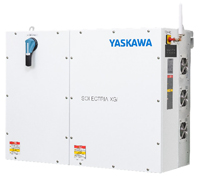
Power conditioner for photovoltaic power generation
XGI1500
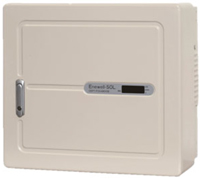
Power conditioner for photovoltaic power generation
Enewell-SOL P2H
[Research and Development] Yaskawa future technology collaborative research program established with Tokyo Institute of Technology
In April 2020, Yaskawa and the Tokyo Institute of Technology established the “Yaskawa Future Technology Collaborative Research Program” for research into ultra-light actuators for human collaborative robots.
Human collaborative robots are robots that operate in the same space as humans, and may share the tasks with the humans or assist in the human tasks. As the first step towards the goal of realizing an ultra-light human collaborative robot ten years from now, we have brought together researchers from areas such as materials, motors and robotics, to work on researching an ultra-light actuator to be used as the driving force. The program teaching staff, the students belonging to the program, and the joint research teaching staff will all work together to combine the technology Yaskawa has cultivated in motors, robots and mechatronics with the wisdom of the Tokyo Institute of Technology, to take on the challenge of realizing a human collaborative robot that aims to expand the applications of robots.
-
Through this program, we also intend to contribute to the nurturing of engineers and researchers who can have excellent and original ideas and play important roles in the future of Japan.
-
Conceptual image of the Yaskawa future technology collaborative research program
[Research and Development] Establishment of the “Technology Research Association ROBOT Industrial Next Generation Basic Technology Collaborative Innovation Partnership”
⑴ Purpose of the technology research partnership establishment
The robot industry in Japan is experiencing an extremely severe competitive environment as the level rises in Asia and globally. To improve our competitiveness, it will be essential that we expand and deepen our basic technology research sector, including regarding its sense of speed. To achieve this, in July 2020, six robot manufacturing companies cooperated to establish the ROBOT Industrial Basic Technology Collaborative Innovation Partnership (abbreviated as “ROBOCIP”). This will strengthen the foundations of our technological innovation and make it possible to promote research with industry-academia collaboration.
⑵ Research contents
We have decided on three research items in the basic technology research field (“research on goods handling and general-purpose motion planning,” “research on remote control technology,” and “research on new materials for robots and sensor application technology”). We will establish elemental technology to achieve the creation of industrial robots that can support areas where they are not yet used, including in sites producing a wide variety of workpieces in small amounts. Furthermore, to aim for the further spread of industrial robots, we will also conduct demonstration testing based on the results we obtain in sites imitating actual workplaces.
-
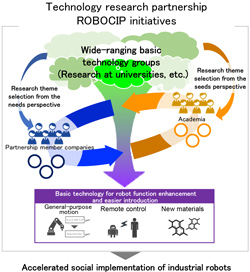
ROBOCIP initiatives
[Research and Development] Receipt of outstanding paper award from the Institute of Electrical Engineers of Japan Industry Applications Society.
On March 31, 2020, the “Simultaneous optimization of orders and parameters in cascade position control system” we presented at the Technical Meeting on Mechatronics Control in September 2019 was awarded an Outstanding Paper Award from the Industry Applications Society of the Institute of Electrical Engineers of Japan. This award was presented to particularly excellent papers from among the excellent paper awards presented by the Mechatronics Control Technical Committee of the Institute of Electrical Engineers of Japan in FY2019.
This technology uses the characteristics data (frequency response data) of machinery to automatically adjust a servo motor controller. The merit of it is that in addition to the PID controllers that are generally used, it is also possible to adjust various filter parameters and numbers. We are working on the research and development with the objective of making it possible for the customer to use servo motors without expending much time or effort. The aim is to realize the technology as an easy-to-use function that embodies plant automation/optimization.
This research is the result of joint research with the Hori-Fujimoto Lab at the University of Tokyo (For details, refer to the Technical Paper “Data Driven Automatic Adjustment of Position Control Systems”).
[Technical Papers] Human Collaborative Robots and Application Examples
In the manufacturing industry at present, in addition to the issues regarding the working-age population shortage and productivity enhancement, there are also demands for a shift of manufacturing to the production of a wide variety of workpieces in small quantities. Human collaborative robots are attracting attention as a method to achieve the construction of production systems where robots and humans work in the same space.
To respond to these demands, Yaskawa is working on the development of human collaborative robots that are both safe and easy to use, and has launched the “MOTOMAN-HC series human collaborative robots.” The safety of these robots is compliant with the ISO10218-1 international standard and they have the merit that their operation and teaching can be easily performed, even by users with little experience in robot operation.
This paper describes the safety and ease of use of the HC series of human collaborative robots, gives examples of their application, and discusses their future prospects.
[Technical Papers]Initiatives to Apply AI-based System to Municipal Wastewater Treatment Plants

Water treatment control support technique

Diagnostic imaging support technique
From FY2018 to FY2019, we developed “Guidance system of operating parameters in wastewater treatment process using AI-based algorithm (random forest)” and “Detecting system of microorganisms in activated sludge using AI-based algorithm (deep learning)” and evaluated for its predicting and detecting power under “Breakthrough by Dynamic Approach in Sewage High Technology (B-DASH) Project”, government-commissioned R&D projects conducted by a national government in Japan. We evaluated the effects of training data volume and random forest parameters on air flow rate and waste activated sludge withdrawal rate predictions by the guidance system. The system was able to predict these operating parameters with acceptable error of less than 10% on annual average basis. These results showed that the guidance system was able to trace the operating parameters by skilled operators with practical error range.
In evaluation of the detecting system, we confirmed the effects of the number of images and parameter settings in deep learning on detection of
Rotaria,
Arcella and
Epistylis. The system was able to detect these microorganisms with acceptable detection accuracy of upper than 80%. These results showed that the system was useful for monitoring activated sludge condition.
This paper summarizes the results mentioned above and describes the initiatives to be taken from now on.
[Technical Papers] Data Driven Automatic Adjustment of Position Control Systems
This paper describes the technique for the automatic adjustment of servo motor position controllers. The merit of this technique is that the controller parameters and the number of filters can be automatically adjusted based on the mechanical characteristics (frequency response data) of the equipment driven by the servo motors. We conducted the automatic adjustment of a position controller to minimize the impact on the position (to optimize the disturbance suppression characteristics) when an external disturbance acts on the equipment, and verified the effect on a single-axis precision positioning device. From now on, we will continue research and development on this technology as an automatic adjustment function for servo motors to embody the automation and optimization of factories centered around the i
3-Mechatronics that Yaskawa is promoting.
This research was one of the outcomes of industry-academia collaboration with the Hori-Fujimoto Lab at the University of Tokyo.
[Technical Papers] Learning Based Bulk Picking System with Flexible Grasping Condition Customization
A practical bulk picking system is required to have a high rate of success in the grasping of various objects, and the flexibility to deal with various constraint conditions related to the improvement of grasping quality, and to changes in those constraint conditions. Yaskawa is proposing a new bulk picking system using a simulator and deep learning to solve these problems. The proposed method achieves the generation of highly precise grasping motion in the real world, and quality improvement through a process which changes the way that data is given to the digital environment of simulators. The system using the proposed method uses deep learning to automatically acquire the generation of high-performance grasping motion for various objects. It also achieves adaptation to the constraint conditions through the refinement and re-learning of the training data for the grasping posture generated in the simulation.
In this paper, an experiment for comparison with the preceding research is conducted and shows the superiority of the proposed method regarding the grasping success rate for objects with different characteristics and regarding the adaptability to the constraint conditions.
 Region
Region



 Principles & vision
Principles & vision
 Procurement
Procurement
 Sustainability for the Yaskawa Group
Sustainability for the Yaskawa Group
 Customer satisfaction
Customer satisfaction
 Supply chain
Supply chain
 Social contribution
Social contribution
 Compliance & risk management
Compliance & risk management



